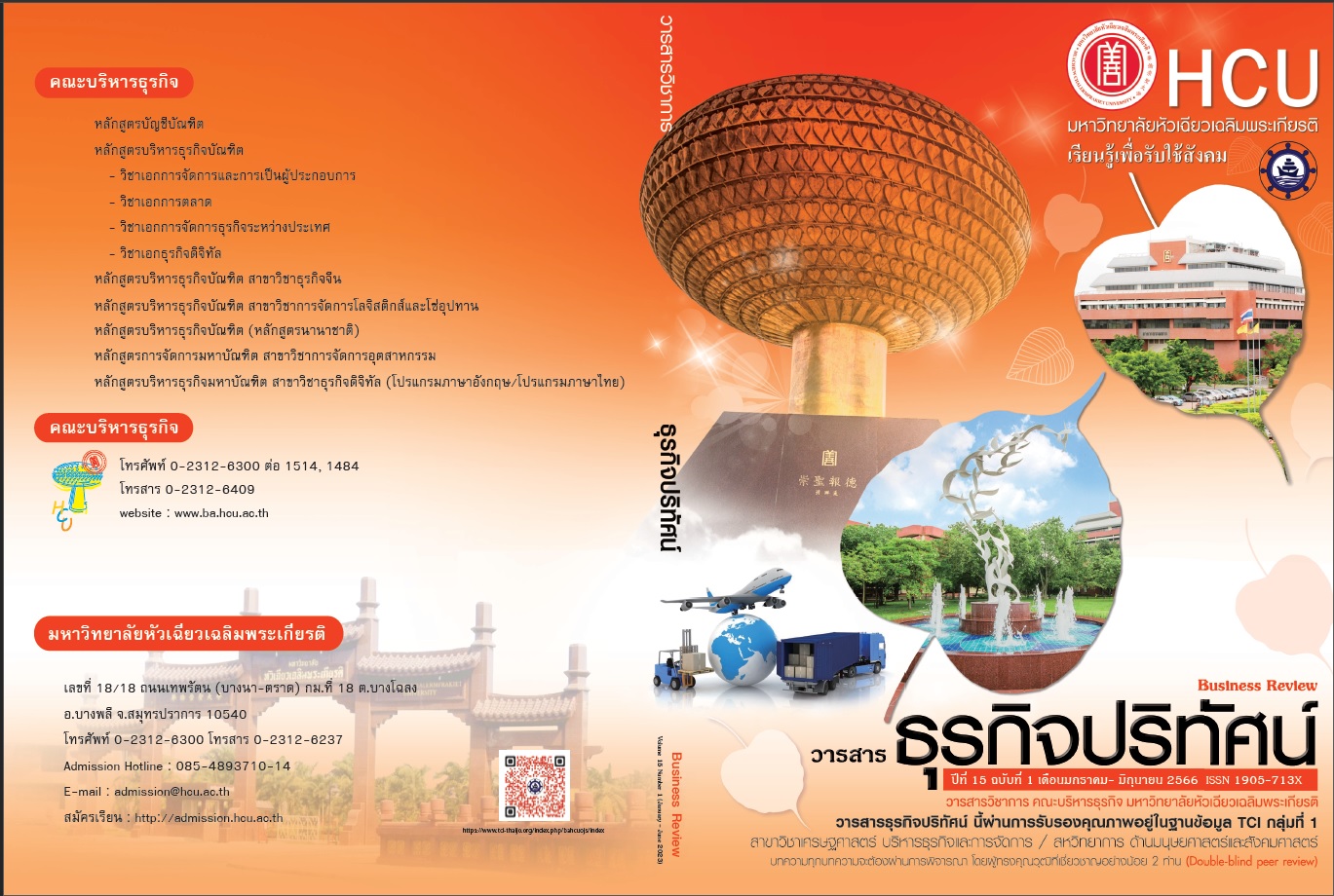The Relationship between Tourism and Economic Growth of Thailand: A Case Study of Economic Growth by Industrial Origin
Keywords:
Cointegration, Short-run Adjustment, Economic Development, Time Series AnalysisAbstract
The purpose of this study is to analyze the relationship between tourism and economic growth by industrial origin including agriculture, manufacturing, and service. The quarterly time series is employed over the period of 1993:Q1 to 2018Q4, a total of 92 observations as well as an analysis using time series techniques consist of (1) stationary test of data by the ADF unit root, (2) long-run equilibrium relationship analysis by the Cointegration, and (3) short-run adjustment by the Error Correction Model (ECM) respectively. The results show that economic growth as a whole and service sector have a long-run equilibrium relationship with tourism, while economic growth in agriculture and industry has a short-run relationship with tourism. The model can explain the overall economic growth including agricultural, manufacturing, and service sectors based on tourism variables as 92.564%, 82.231%, 86.844%, and 95.366% respectively.
References
กรมการฝึกหัดครู. (2533). การท่องเที่ยว. กรุงเทพฯ: ภาคพัฒนาตำราและเอกสารวิชาการ หน่วยศึกษานิเทศก์ กรมการฝึกหัดครู.
คณะกรรมการนโยบายการท่องเที่ยวแห่งชาติ. (2560). แผนพัฒนาการท่องเที่ยวแห่งชาติ ฉบับที่ 2 (พ.ศ. 2560 - 2564). กรุงเทพฯ: การท่องเที่ยวแห่งประเทศไทย สำนักงานปลัดกระทรวงการท่องเที่ยวและกีฬา.
วีระศักดิ์ โควสุรัตน์. (2562). สถานการณ์การท่องเที่ยวปี 2561 และแนวโน้มปี 2562. สืบค้นเมื่อ 22 กุมภาพันธ์ 2562, จากกระทรวงการท่องเที่ยวและกีฬา เว็บไซต์: https://www.mots.go.th/ewt_dl_link.php?nid =11273
สำนักงานปลัดกระทรวงการท่องเที่ยวและกีฬา. (2562). สถานการณ์การท่องเที่ยว เดือนธันวาคม 2561. สืบค้น เมื่อ 24 กุมภาพันธ์ 2562, จากกระทรวงการท่องเที่ยวและกีฬา เว็บไซต์: https://www.mots.go.th/ ewt_dl_link.php?nid=11272
อัครพงศ์ อั้นทอง. (2557). การตรวจสอบสมมติฐาน Tourism-led Growth: กรณีศึกษาประเทศไทย. วารสาร เศรษฐศาสตร์ประยุกต์, 21(2), 30-51.
Akinboade, O. A., & Braimoh, L. A. (2010). International tourism and economic development in South Africa: A Granger causality test. International Journal of Tourism Research, 12(2), 149-163.
Asteriou, D., & Hall, S. G. (2007). Applied econometrics: A modern approach using EViews and Microfit. (Revised edition). New York: Palgrave Macmillan.
Cottrell, A., & Lucchetti, R. (2020). Gretl user’s guide: Gnu regression, econometrics and time series library. Retrieved April 20, 2020, from Gnu Regression, Econometrics and Time- series Library Website: http://gretl.sourceforge.net/gretl-help/gretl-guide.pdf
Dickey, D. A., & Fuller, W. A. (1979). Distribution of the estimators for autoregressive time series with a unit root. Journal of the American Statistical Association, 74(366a), 427-431.
Dickey, D. A., & Fuller, W. A. (1981). Likelihood ratio statistics for autoregressive time series with a unit root. Econometrica: Journal of the Econometric Society, 1057-1072.
Engle, R. F., & Granger, C. W. (1987). Co-integration and error correction: Representation, estimation, and testing. Econometrica: Journal of the Econometric Society, 251-276.
Granger, C. W. J., & Newbold, P. (1974). Spurious regressions in econometrics. Journal of Econometrics, 2(2), 111-120
Gujarati, D. N., & Porter, D. (2009). Basic econometrics. (Fifth edition). New York: McGraw Hill.
Katircioglu, S. T. (2009). Revisiting the tourism-led-growth hypothesis for Turkey using the bounds test and Johansen approach for cointegration. Tourism Management, 30(1), 17-20.
Kim, H. J., Chen, M. H., & Jang, S. S. (2006). Tourism expansion and economic development: The case of Taiwan. Tourism Management, 27(5), 925-933.
Kumar, S., & Sharma, D. (2017). Study of ICT and tourism led growth in India and Thailand. Social Science Asia, 3(3), 24-31.
Lean, H. H., & Tang, C. F. (2010). Is the tourism‐led growth hypothesis stable for Malaysia? A note. International Journal of Tourism Research, 12(4), 375-378.
Lee, C. G. (2010). Health care and tourism: Evidence from Singapore. Tourism Management, 31(4), 486-488.
Lee, C. G., & Hung, W. T. (2010). Tourism, health and income in Singapore. International Journal of Tourism Research, 12(4), 355-359.
Nonthapot, S. (2013). Tourism and economic growth of Thailand testing: New evidence from ARDL and rolling window approaches. International Journal of Applied Business and Economic Research, 11(2), 251-260.
Nonthapot, S., & Watchalaanun, T. (2015). Relationship between tourism expansion and telecommunication in Thailand. Journal of Environmental Management and Tourism, 6(1), 37.
Oh, C. O. (2005). The contribution of tourism development to economic growth in the Korean economy. Tourism Management, 26(1), 39-44.
Tang, C. H. H., & Jang, S. S. (2009). The tourism-economy causality in the United States: A sub- industry level examination. Tourism Management, 30(4), 553-558.
Toda, H. Y., & Yamamoto, T. (1995). Statistical inference in vector autoregressions with possibly integrated processes. Journal of Econometrics, 66(1-2), 225-250.
UNWTO. (2018). UNWTO Tourism highlights 2018 edition. Retrieved June 20, 2019, from World Tourism Organization Website: https://www.e-unwto.org/doi/pdf/10.18111/9789284419 876
Downloads
Published
How to Cite
Issue
Section
License
Copyright (c) 2023 Business Review Journal

This work is licensed under a Creative Commons Attribution-NonCommercial-NoDerivatives 4.0 International License.
All articles published in the Business Administration and Management Journal Review are copyrighted by the journal.
The views and opinions expressed in each article are solely those of the individual authors and do not represent those of Huachiew Chalermprakiet University or any other faculty members. Each author is fully responsible for the content of their own article. Any errors or issues found are the sole responsibility of the respective author.




